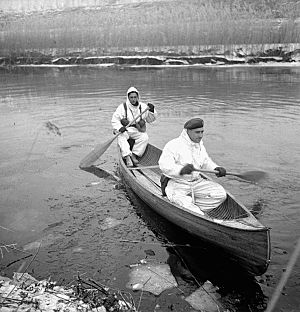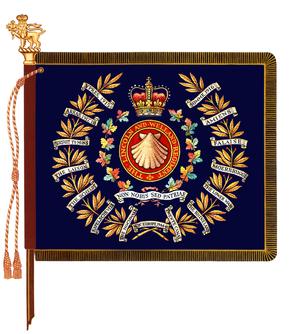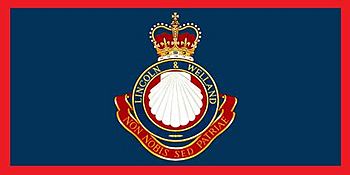The Lincoln and Welland Regiment facts for kids
Quick facts for kids The Lincoln and Welland Regiment |
|
|---|---|
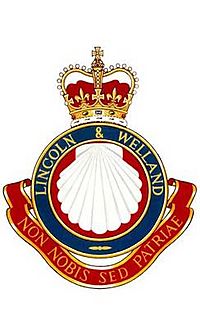
The badge of the Lincoln and Welland Regiment
|
|
| Active | 1863–present |
| Country | |
| Branch | |
| Type | Line Infantry |
| Role | Light Infantry |
| Size | One battalion |
| Part of | 32 Canadian Brigade Group |
| Garrison/HQ | St. Catharines, Ontario |
| Motto(s) | Latin: Non nobis sed patriæ, lit. 'Not for ourselves but for our country' |
| March | "The Lincolnshire Poacher" |
| Commanders | |
| Current commander |
LCol C.J. Canavan, CD |
| RSM | CWO F. Randall, CD |
| Colonel-in-chief | Sophie, Countess of Wessex |
The Lincoln and Welland Regiment is a special army group in the Canadian Army. It is made up of soldiers who train part-time, called the Primary Reserve. This regiment is based in St. Catharines and Welland, Ontario.
The regiment's special leader, called the Colonel-in-Chief, is Sophie, Countess of Wessex. The regiment's motto is in Latin: Non nobis sed patriæ, which means "Not for us but for our country".
Contents
What is the Regimental Badge?
The badge of the Lincoln and Welland Regiment is full of meaning. The crown on the badge shows the regiment's loyalty to the King or Queen. The overall shape of the badge comes from an older group called The Lincoln Regiment.
The shell symbol, called an escallop, was used by the old County of Welland. It is also part of the badge. The words "LINCOLN and WELLAND" are the regiment's name. Below that, the motto "NON NOBIS SED PATRIAE" reminds everyone that they serve their country, not just themselves.
How the Regiment Started
The Lincoln and Welland Regiment has a long history. It began in St. Catharines, Ontario, on March 18, 1863. Back then, it was known as the 19th Battalion Volunteer Militia (Infantry), Canada. Over the years, its name changed several times.
In 1936, two older groups, The Lincoln Regiment and The Lincoln and Welland Regiment, joined together. They became what we know today as The Lincoln and Welland Regiment. During the Second World War, it was called the 2nd (Reserve) Battalion, The Lincoln and Welland Regiment. After the war, in 1946, it went back to its current name.
Important Groups the Regiment Remembers
The Lincoln and Welland Regiment keeps the memory of several older military groups alive. This is called "perpetuation."
These include:
- The Battalion of Incorporated Militia of Upper Canada
- The Coloured Corps (also known as Captain Runchey's Company of Coloured Men)
- The 1st, 2nd, 3rd, 4th, and 5th Regiments of Lincoln Militia from the War of 1812
During the First World War, the regiment also remembers three Canadian Expeditionary Force battalions:
- The 81st Battalion, CEF
- The 98th Battalion (Lincoln & Welland), CEF
- The 176th Battalion (Niagara Rangers), CEF
Early History: 1794–1863
In 1794, a leader named John Butler was in charge of the Nassau Militia. Many of his soldiers had fought with him before and received land in Niagara. By 1792, the militia was renamed the Lincoln Militia. It had three battalions and about 849 soldiers.
By 1808, there were five different regiments of the Lincoln Militia. These groups were made up of soldiers from different townships in the area.
During the War of 1812, special companies from these five regiments fought in major battles. They helped defend Canada in places like Queenston Heights, Lundy's Lane, and Fort Detroit. These soldiers were very brave and helped protect their country.
Later, during the rebellion in 1837, parts of the Lincoln Militia were called to stop uprisings. In 1846, Lincoln County was divided, and Welland County was formed. The militia groups were then called "battalions."
Regiment in Action
Fenian Raids
The 19th Battalion Volunteer Militia (Infantry), Canada was called to active duty in June 1866. They served along the Niagara border to protect the area. They finished their duty later that month.
Another time, in May 1870, the 19th "Lincoln" Battalion of Infantry was called out. They also served on the Niagara border for a short period.
First World War

When the First World War began in August 1914, the 19th "Lincoln" Regiment and 44th Lincoln and Welland Regiment were put on active duty. Their job was to protect the Welland Canal Force in their local area.
Several battalions linked to the regiment also played a role:
- The 81st Battalion, CEF went to Britain in 1916. They helped send new soldiers to the Canadian forces fighting in Europe.
- The 98th Battalion (Lincoln & Welland), CEF also went to Britain in 1916. They provided more soldiers for the Canadian forces.
- The 176th Battalion (Niagara Rangers), CEF traveled to Britain in 1917. Their soldiers also joined other units to help the Canadian forces.
Second World War
Before the Second World War, the regiment did not have much training. In 1936, the two units joined to form The Lincoln and Welland Regiment. They had about 467 soldiers.
The regiment was called to duty in August 1939. They were first used for local protection. By 1940, they became the 1st Battalion, The Lincoln and Welland Regiment, CASF. They served in British Columbia and Newfoundland to defend Canada.
In 1943, the 1st Battalion went to Britain. In July 1944, they landed in France as part of the 4th Canadian Armoured Division. They fought bravely across North-West Europe until the war ended.
The regiment was involved in many important battles. Over 1500 soldiers from the regiment were injured or lost their lives. When the war ended, only a few of the original soldiers who joined in 1940 were still with the battalion.
A special tank named "Press-On" became a mascot for the regiment. It was damaged in battle but repaired by the soldiers. This tank is now displayed in front of the armoury in St. Catharines, Ontario.
After the Wars
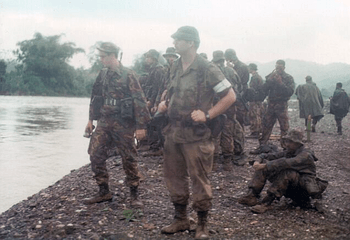
After the Second World War, the regiment took on many tasks. They participated in parades and provided guards for important visitors. This included visits from Queen Elizabeth II and her mother, Queen Elizabeth the Queen Mother.
In 1977, during a huge snowstorm in Niagara, the regiment helped people. They rescued over 1500 stranded schoolchildren and assisted many residents. For their help, they received thanks from the Canadian Parliament. The regiment also sent volunteers to help during the 1997 Red River flood and the 1998 Ice Storm.
In 1994, the regiment celebrated its 200th anniversary. They held special events to remember their long history of service.
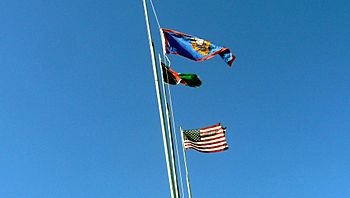
In 2012, Sophie Countess of Wessex presented new flags, called colours, to the regiment. These new colours included a special honour for the battle of Niagara. This links the regiment to the War of 1812 battles like Detroit and Queenston Heights.
War in Afghanistan
From 2002 to 2014, the regiment sent many of its soldiers to serve in Afghanistan. More than 20% of their total strength helped with various missions there.
Battle Honours
Battle honours are special awards given to military units for their bravery in important battles or campaigns. The ones in bold can be shown on the regiment's flags.
War of 1812
First World War
- Ypres, 1915, '17
- Festubert, 1915
- Somme, 1916
- Arras, 1917, '18
- Hill 70
- Amiens
- Hindenburg Line
- Pursuit to Mons
Second World War
- Falaise
- Falaise Road
- The Laison
- Chambois
- The Seine, 1944
- Moerbrugge
- The Scheldt
- Breskens Pocket
- The Lower Maas
- Kapelsche Veer
- The Rhineland
- The Hochwald
- Veen
- Twente Canal
- Friesoythe
- Küsten Canal
- Bad Zwischenahn
- North-West Europe, 1944–1945
South-West Asia
- Afghanistan
Friends and Partners
The Lincoln and Welland Regiment has special connections, called alliances, with other military groups around the world:
 United Kingdom – The Royal Anglian Regiment
United Kingdom – The Royal Anglian Regiment United Kingdom – The Rifles
United Kingdom – The Rifles Bermuda – The Royal Bermuda Regiment
Bermuda – The Royal Bermuda Regiment Australia – The Royal Queensland Regiment
Australia – The Royal Queensland Regiment New Zealand – The Wellington (City of Wellington's Own) and Hawke's Bay Regiment
New Zealand – The Wellington (City of Wellington's Own) and Hawke's Bay Regiment
The regiment also works with cadet groups in St. Catharines and Fonthill. They are also connected to Robert Land Academy in Wellandport.
Regimental Music
The regiment has its own special music. A piece called Old Niagara waltzes was dedicated to the 44th Lincoln and Welland Regiment around 1905.
The official regimental march is now The Lincolnshire Poacher. This song became their march after the regiment's name changed over the years.
Lincoln and Welland Regimental Museum
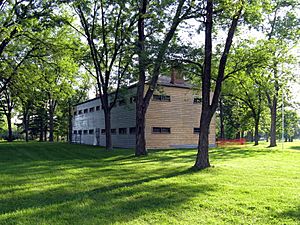 |
|
| Location | Butler's Barracks in Niagara-on-the-Lake, Ontario Canada |
|---|---|
The Lincoln and Welland Regimental Museum is located at Butler's Barracks in Niagara-on-the-Lake. This museum tells the story of the regiment's history.
Inside, you can see uniforms, weapons, medals, and old photographs. There are also musical instruments from the regimental band. The displays show how the regiment took part in battles from the 1700s to today. This includes their roles in World War I, World War II, and peacekeeping missions.
The museum is connected to several important museum organizations. However, there is no online exhibit for the Lincoln and Welland Regiment yet.
Order of Importance
| Preceded by The Hastings and Prince Edward Regiment |
The Lincoln and Welland Regiment | Succeeded by 4th Battalion, The Royal Canadian Regiment |


